The American City Envied by Foreign Visitors
Plus, the C&O Canal gets some love, the demise of music festivals, Thailand's struggles, NYC gimmick architecture and the luxury crutch.
Thousands, if not millions, of Americans will wander around European metropolises this summer, turn to each other and ask, “Why can’t we have this back home?”
At the same time, in a corner of the U.S. that historically has been not only overlooked but dreaded by those who had to move there for work, tourists and civic officials from around the world are asking the same thing.
It may come as a surprise, then, that the subject of such envy is the rapidly growing city of Bentonville, Arkansas.
I first fell under the charm of Northwest Arkansas nearly a decade ago while visiting Tulsa. I had a day to kill, so I drove a couple of hours east to check out Crystal Bridges and the Mildred B. Cooper Memorial Chapel in Bella Vista. Founded by Alice Walton, one of the heirs to the eye-watering Walmart fortune, Crystal Bridges was then the hot new museum attraction. E. Fay Jones, the architect of the Cooper Chapel and the most successful of Frank Lloyd Wright’s acolytes, was a man I’d long admired from a distance. The sojourn was one full of temptation, as this corner of the U.S. is one of its most effortlessly beautiful, and there turned out to be far more to see than I’d thought.
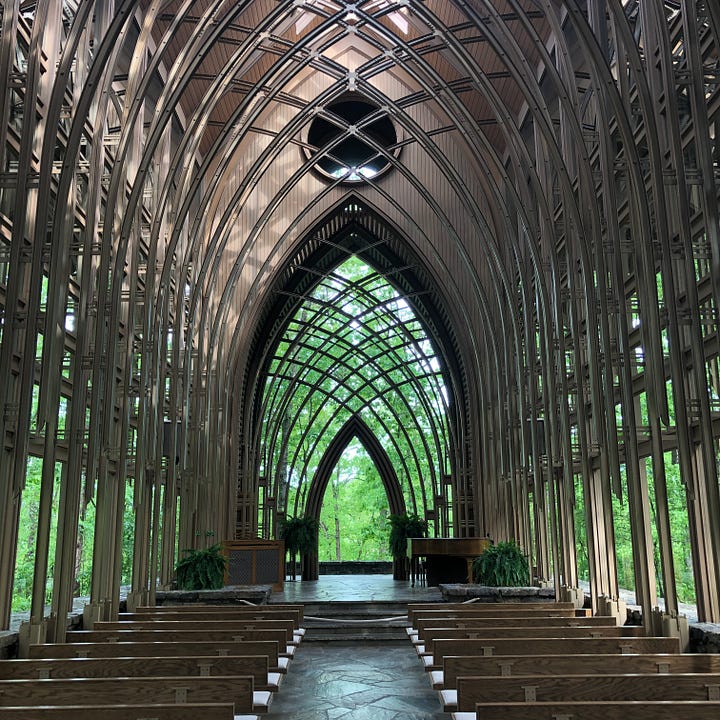
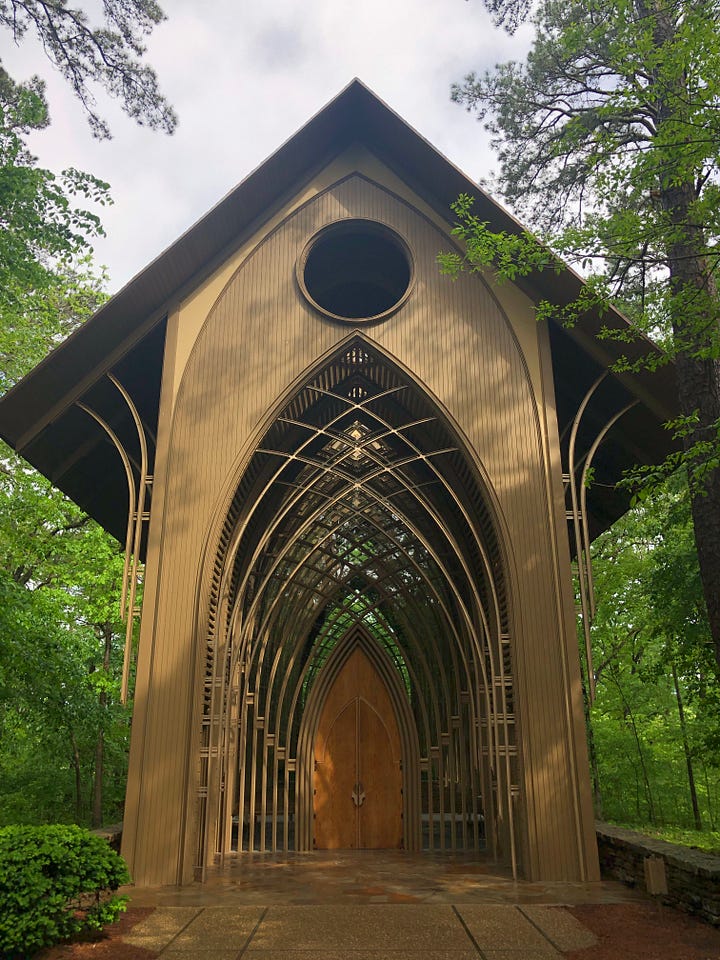
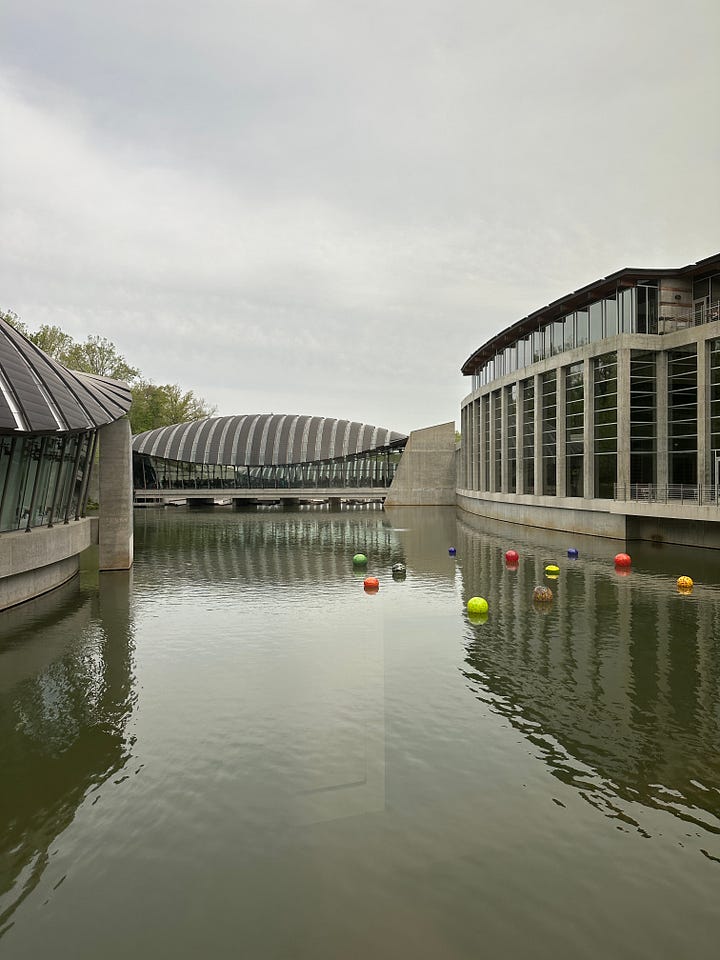

This spring I got to return, as part of a road trip exploring a few destinations in Arkansas. But for this newsletter, it is Bentonville that I’ll focus on.
If you want a town that captures so much of modern American life right now, Bentonville is a great place to start. Part of the Northwest Arkansas metropolitan area, which also includes Fayetteville, Rogers, and Springdale, it’s surrounded by the Ozark Mountains and a chain of man-made lakes. Long synonymous with Walmart, which is headquartered here, it was once an undesirable destination for most folks from elsewhere to have to move to. In the last few years, though, the population has increased by 14 percent. It’s become a destination for digital nomads eager to capitalize on its outdoor lifestyle.
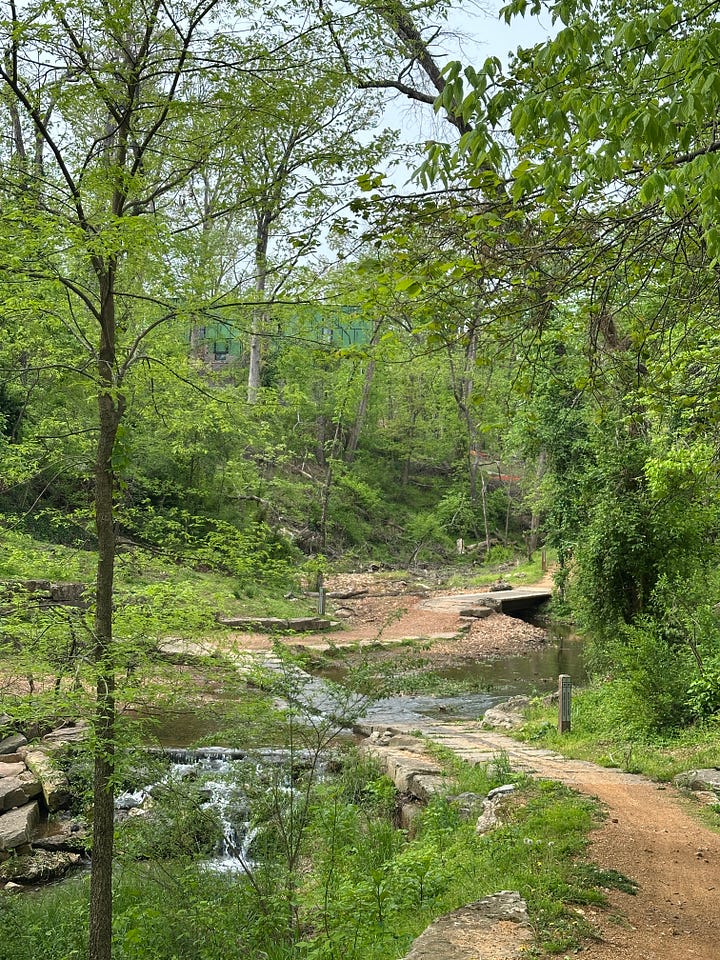
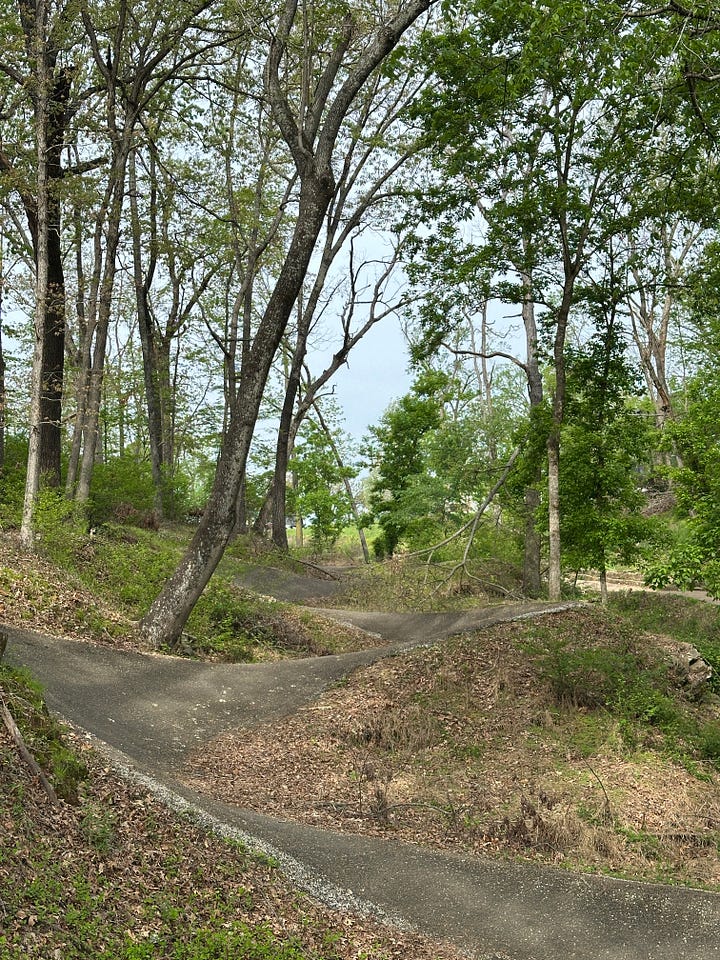
That’s because slicing and curving through ravines, gullies, and hollers alongside busy multi-lane roads and strip malls, is a dizzying array of world-class mountain biking trails. As in the U.S. writ large, the car will not be curbed here. But that hasn’t stopped creative individuals like Gary Vernon, Director of Outdoor Recreation & Trail Innovation for the Runway Group, from building more than 200 miles of trails that curve, drop, climb, and shoot into the canopy of trees around here. On one of my bike rides cruising the trails, I saw expert riders soaring off jumps, families cruising in the woods together, and elderly couples set up in beach chairs on the smooth white stone banks of the crystal clear river that snakes alongside the main path.
The bike trail story—too long to recount here—is one of those “if you build it they will come.” If you spend just a few minutes with him, Vernon is one of those people who will restore your faith in the battered American ideal that hard work and good people get rewarded in the long run. The YouTube video of his TedTalk embedded above is worth a watch. These bike trails are bringing thousands of tourists from around the world, and hundreds of politicians and public planners eager to replicate the success of the bike trails.
If you want to take your biking journey here to the next level, there is a new helicopter operator—Heli Oz—that specializes in taking enthusiasts to the various landing strips in the mountains and lakes surrounding Bentonville for epic backcountry biking.
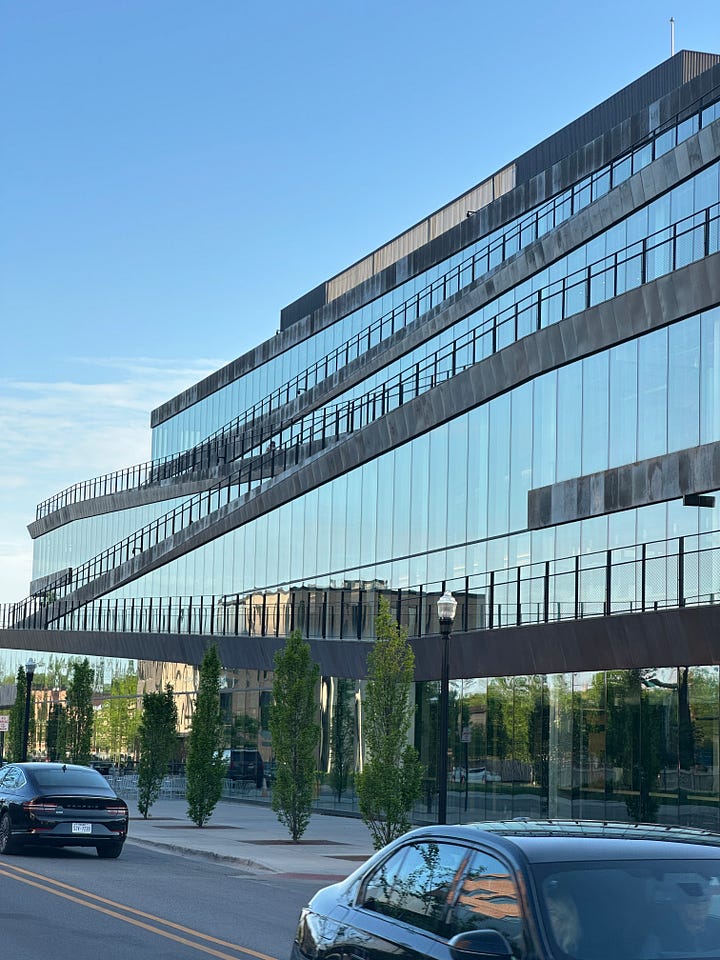
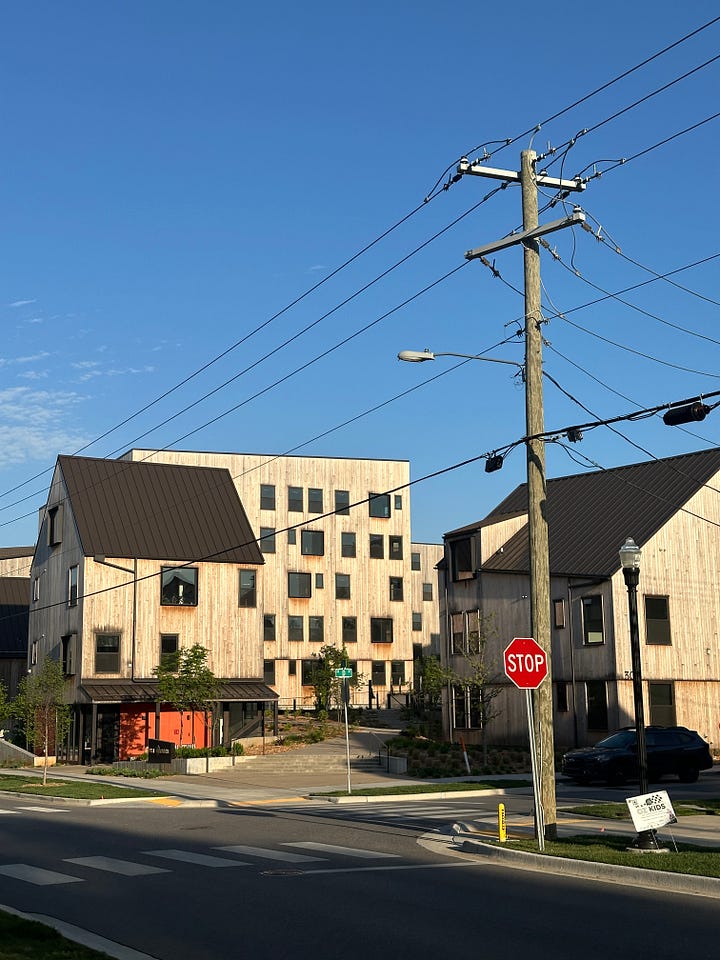
It’s not just bike trails, though, that have made Bentonville so alluring. The town’s historic center is something out of an Americana movie set, a place where a heaping portion of ice cream can be had for a buck or two. That historic core is surrounded by some of the more innovative contemporary architecture I’ve seen of late, including the fully bikeable office building The Ledger and the award-winning Thaden School. There’s even a new hotel, a Motto by Hilton, right across from The Ledger, where I stayed during my visit.
While I’ve had some real disappointments over the years stopping in Arkansas for dinner on road trips, I ate well this time around, albeit with portion sizes that left me feeling like I should be rolled home. The Preacher’s Son and Conifer are two higher-end New American restaurants right in town that will satisfy any coastal snob. I also enjoyed Wright’s Barbecue (named the best in Arkansas), Yeyo’s Yellow Truck (tacos and burritos), and Onyx Coffee (got some ground coffee to take home to family).
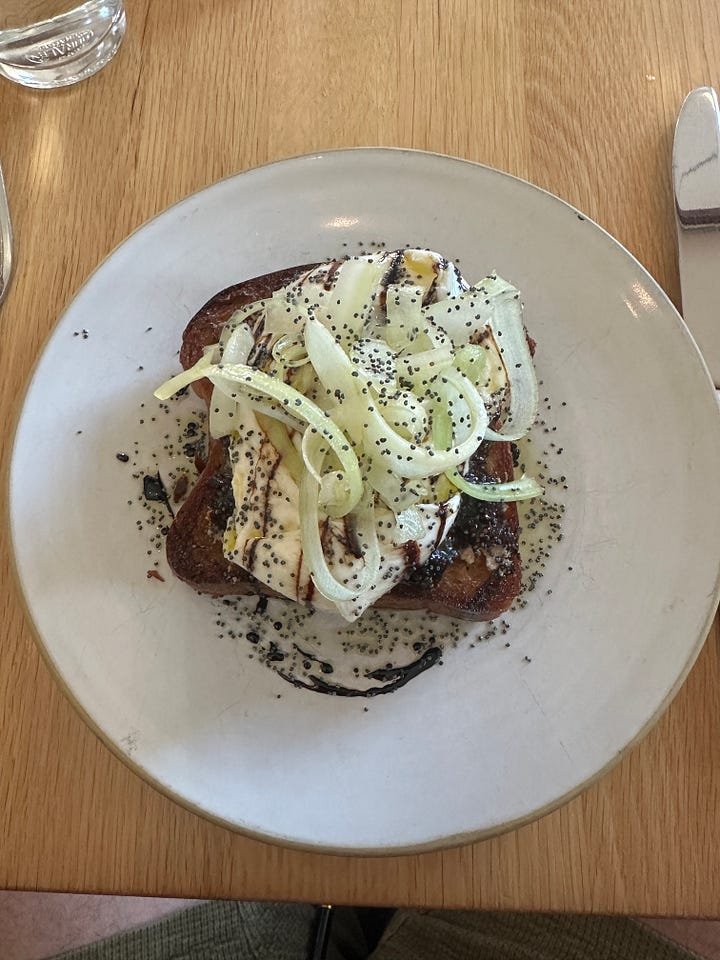

The main star of Bentonville, and the institution that put it on the cultural map, is the Crystal Bridges Museum of American Art. Designed by Moshe Safdie, it’s always looked to me like a bunch of concrete armadillos. Inside is one of the more serious of the billionaire museums that have sprung up worldwide in the last couple of decades. Little here screams tax carveout or vanity project. It’s free, and you can traipse in right off a trail ride should you want. Unlike something like, say, the Bourse de Commerce Pinault Collection in Paris, not only is Crystal Bridges free, but it has a relentless stream of educational activations and public lectures, and provides a cultural amenity in a region that wasn’t exactly drowning in them. Plus, it has an agenda—elevating and championing American art—that is clear and useful. So popular has it become that construction is already underway to increase its size by 50 percent.
Tucked behind Crystal Bridges, up a street currently closed for construction, is a house that if I was ever able to pigeonhole a member of the Walton family I’d beg them to also make available to the public.
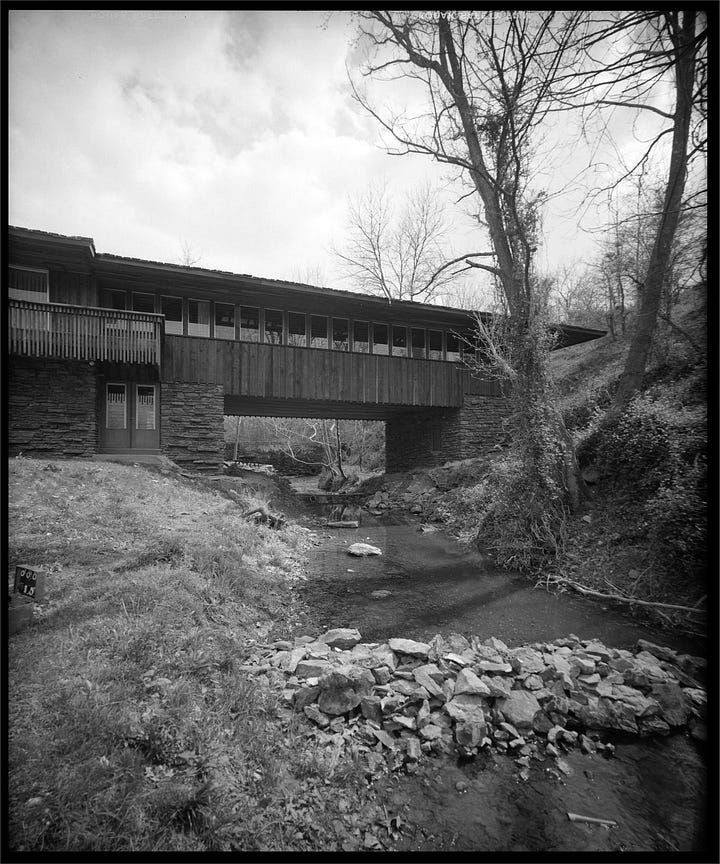
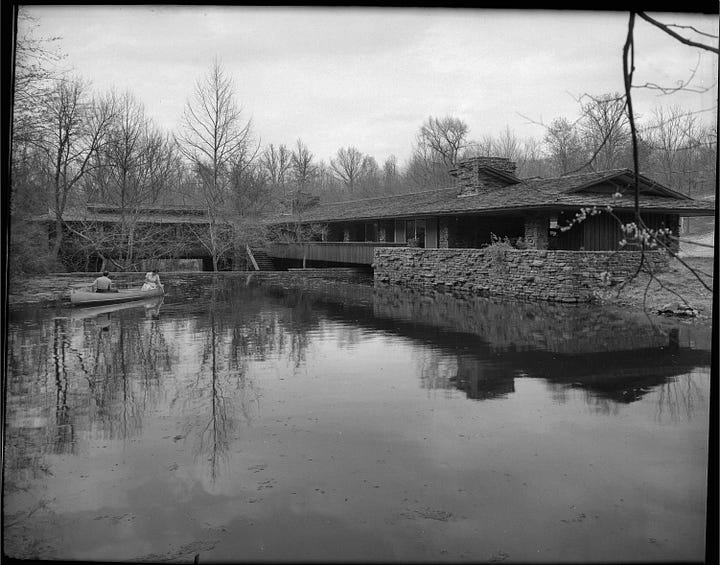
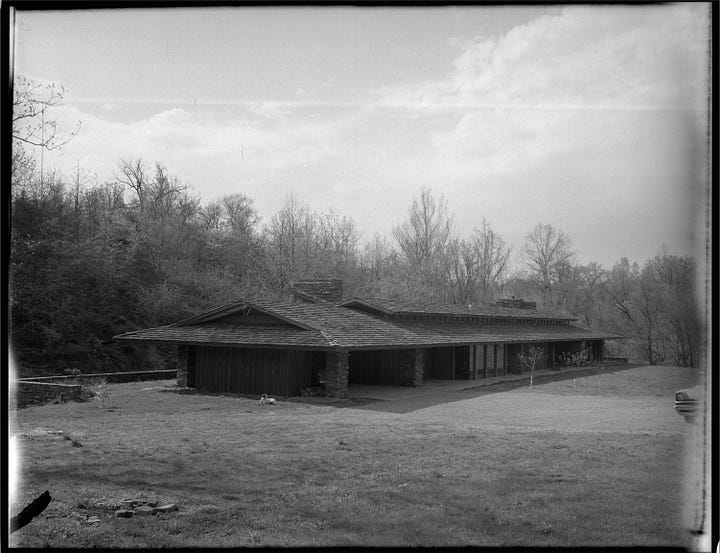
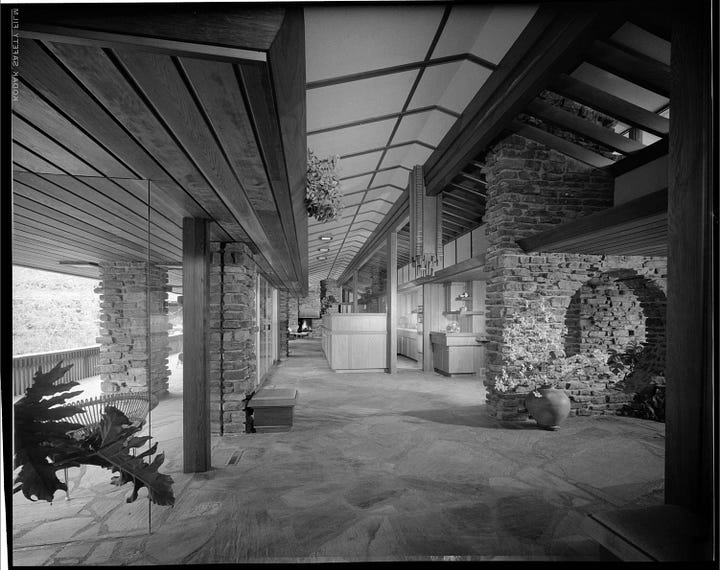
When the founder of Walmart, Sam Walton, made it big he turned to a local architect to build his home. Now, Walton was fortunate in that the local architect in question was E. Fay Jones, an acolyte of both Bruce Goff and Frank Lloyd Wright. Wright in particular saw Jones as a true inheritor of their vision. Jones was the original reason I came to Arkansas all those years ago. Two of his chapels in the surrounding area—Cooper Chapel and Thorncrown Chapel—are take-your-breath-away transcendent works of organic architecture.
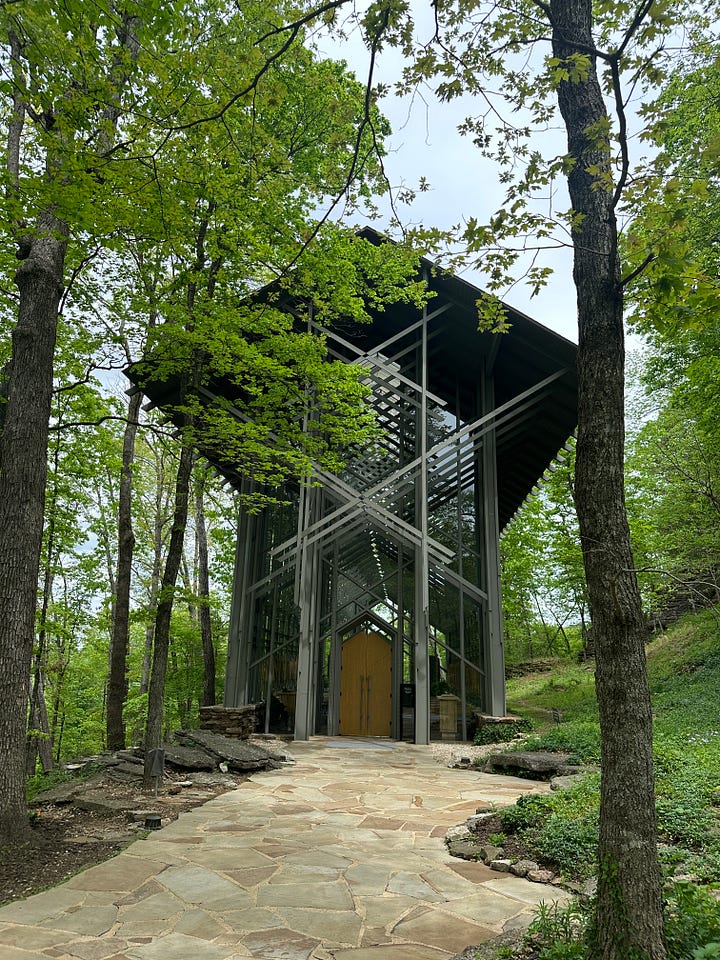
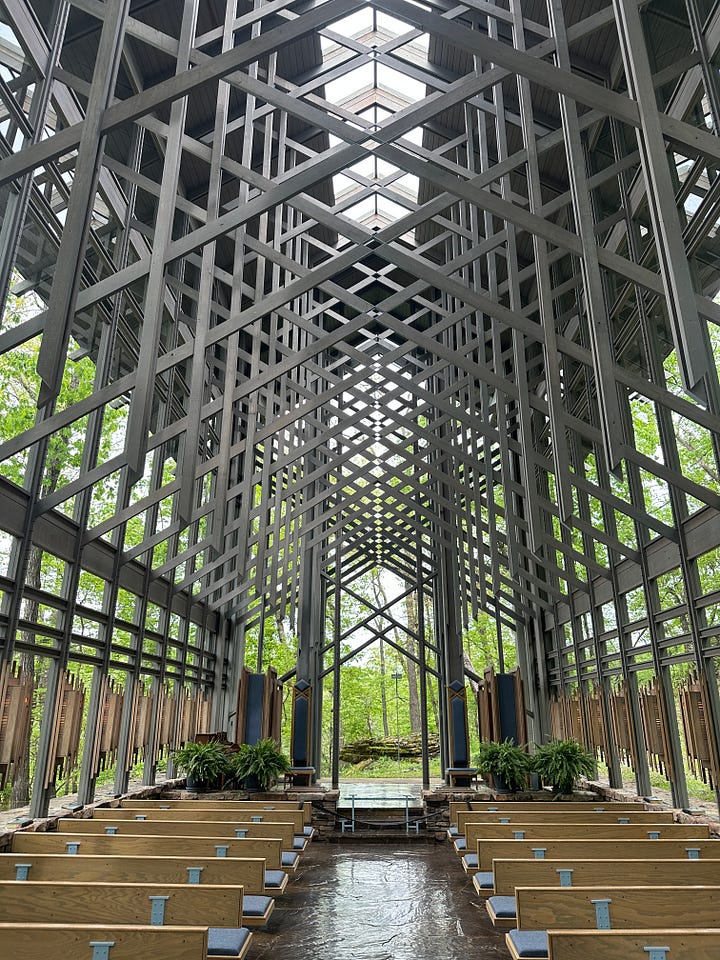
But Jones also designed dozens of houses in the region in his version of organic architecture that—at least in images—I’ve long preferred to Wright’s. Bill Clinton once lived in a Jones-designed house and wrote years later about how much he loved it. And I think opening up the house Jones designed for Walton, which remains one of his signature works, would do so much to boost the legacy of somebody who should be a household name and do incredible things to promote the rich native history that this region has always had.
Whether or not the Waltons ever decide to open the Sam Walton House to the public, I’ll be keenly watching Bentonville’s continuing rise. Despite our fantasies of European-style urbanism here, this is sort of an answer to what modern American life can be. It’s lifestyle focused, which means biking and quick access to the lakes and mountains. Sure, it’s also having stuff like restaurants and shops in walking distance, but never fully giving up the car and big houses. And, the companies in the area are heavily engaged, recognizing that a shrinking labor force that is increasingly mobile requires ensuring you’ve got nice stuff so that people don’t shiver at the thought of moving there.
DEPARTMENT OF GRIEVANCES
One of a number of reasons I don’t like overnight flights (I barely fit even in business class lay-down seats, the few hours of sleep is not worth the price, etc) is often timing. Even if I manage to fall asleep during the portion of the flight deemed sleep-time, i.e. when the lights are turned off and service is over, it’s often such a tiny portion. The flight to London from D.C. is now roughly six-and-a-half hours, out of which maybe four are conducive to sleep. To continental Europe, that number stretches to five. And that’s assuming there aren’t other factors at play. It’s why the daytime flight to London (nicknamed “the chairman’s flight”) is always my go-to. I do think, however, that some version of Amtrak’s Quiet Car should exist for long-haul flights where a section of the plane basically has a “Do Not Disturb” function. No lights will be on, no service, etc.
If I ever get to the point where I need a hair transplant, I’m going to need way more information than this person who wrote about flying to Turkey for the popular surgery for New York Magazine…
The long-awaited metro station for LAX (Los Angeles International Airport) is finally open! The automated people mover train won’t be ready until next year, though, so for now a shuttle bus will be taking travelers from the station to the terminal. Now, I wasn’t paying close attention to this but it’s remarkable to me they built the station 2.5 miles (!!) from the actual terminal. I don’t know the particulars, but public transit really, really needs to do a better job of requiring less work to utilize than its planners in the U.S. give us. It sounds terrible to take a long metro ride to then get on a 2.5 mile people mover to the terminal.
I love Brightline as much as anybody, if not more so, but I have to agree with the folks at One Mile at a Time that its new partnership with JetBlue is kind of a snooze. I hope it’s just the start to bigger and more enticing things, but for now I’m just glad that this might get more people aware of Brightline.
I don’t know why they’re banging on about it (my guess is because it got national attention and once you’ve got a story that has national play you pursue it until you’ve wrung every last drop) but Thrifty Traveler’s obsession with airlines offering deals for group/family travel is getting tiresome. First of all, the outlet is acting like this is some outrageous act by the airlines. But if you stop using Thrifty Traveler’s framing (airlines are overcharging solo travelers!) to one most people would use (airlines are discounting fares for groups and families) it really doesn’t seem like something worth getting in a lather about. And clearly the airlines don’t care. They’ve not only restarted the practice after pulling back when the news went national, but they still haven’t bothered to explain why they’re doing it at all.
One of the best urban amenities in the world—the C&O Canal in Washington, D.C.--was also wonderful because few tourists know about it or bother trying to access it. So I’m happy to see it get its due in the Wall Street Journal this week, but nervous about the people it might bring!
As episode after episode of the latest season of White Lotus rolled out, my inbox filled with stories about how Thailand was going to feel the “White Lotus effect” that Sicily did after the second season. But that always felt lazy to me, as the property and setting didn’t sparkle quite as much this season on camera as the last, and nearly every press hit the cast did had them talking about how miserable they were with the weather and bugs! Bloomberg is out with new reporting that despite the show, Thailand’s tourism numbers have continued their steady decline each month this year. A lof of that is attributable to events specific to Asia, as Chinese and Malaysian tourists are the two big drivers there. But even their 12 percent increase year-over-year in Americans isn’t that massive a gain compared to other tourism hotspots post-pandemic.
Bloomberg is also out with a great new column by Kristen Bellstrom about how blindly the entire travel industry has followed the new wisdom of luxury travel. “Americans,” she notes, “have increased their travel spending every year since the 2020 bust.” The most important group is what is being called “the aspirational set” by McKinsey. They have a net worth of between $100,000 and $1 million, and make up 35% of the global luxury travel market. Everything from hotels to airlines to Airbnb’s recent Services rollout is looking to cash in on this group, but that might be a mistake, Bellstrom argues, if you look at the recent demolition of the luxury retail market as a parallel. Sure, travel has shown to be more important to millennials than fashion. But for how long?
Construction has started up again on 740 Eighth Avenue, aka “The Torch,” which means New York City’s once-elegant skyline is getting yet another gimmick tower. It’s hard because I get the appeal and I’m sure some of these actually will become beloved over time, but all it takes is a pair of eyeballs to appreciate the difference between the skyline of New York City and Chicago and, say, Doha.
If you’re suffering from FOMO because you’re not at Primavera Sound right now or you didn’t make it to Coachella, don’t fret. The friends you see at festivals don’t reflect reality, as the entire business is limping right now, reports CNN. Dozens of major festivals have been canned this year alone, and other big ones have faced issues selling all of their tickets.
TRAVEL INDUSTRY NEWS
Dating apps are being used in Mexico to lure and kidnap tourists
Expect to hear as much about padel as pickleball in the future when it comes to resort amenities
Uber will offer helicopter rides to Capri this summer
India’s largest airline, IndiGo, is partnering with Delta, Air France/KLM, and Virgin
United slows rollout of Starlink WiFi due to interference issue
A lion killed a man at a luxury lodge in the remote northwest of Namibia
Norway is introducing a tourist tax
Capital One is slashing access for its lounges due to long lines
The White House issued an executive order lifting a ban on overland supersonic flight
It is also sunsetting the TSA Quiet Skies program which put people on a TSA watch list
The Peninsula Hotel in Chicago is the best hotel in the U.S. based on guest reviews
The Senate is proposing to slash Brand USA’s funding by 80%
Los Angeles tourism has fallen off a cliff
Egypt and Saudi Arabia say they’re ‘ready to implement’ a new bridge or tunnel connecting the two





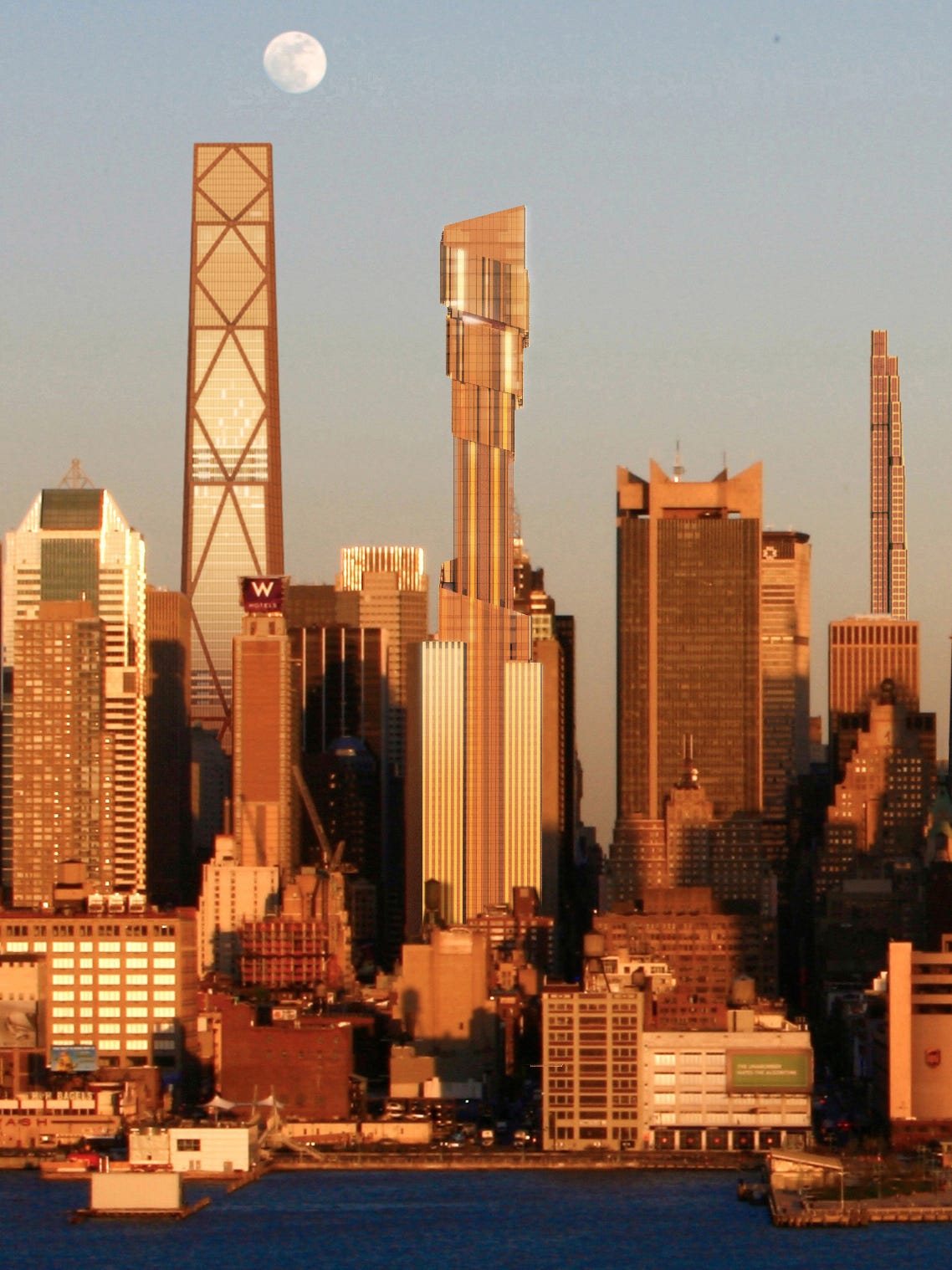
On the LAX Metro station, it was the usual challenge of cost effectiveness. They would have had to tunnel the line into the LAX horseshoe and, at least according to their analysis, doing so brought only a marginal number of additional riders over the 2.5-mile-away station and APM ride. Hence they built it the way they did.
It's not perfect for sure but an improvement. The question remains, with LA so spread out, how many people will even ride the Metro to the airport? It's already one transfer from downtown without including the APM.